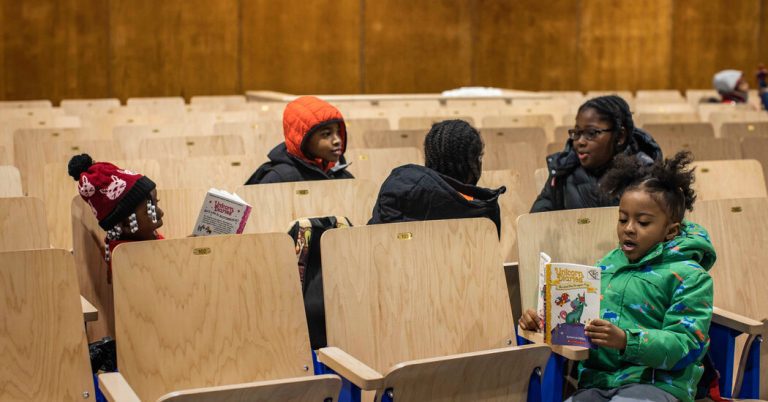It sounds like a dream for some working parents: school for 12 hours a day, starting bright and early at 7am and finishing after dinner at 7pm, all for free.
One elementary school, Brooklyn Charter School, is experimenting with the idea as a way to tackle two problems at once. The first is the sharp decline of students in urban schools. Families are leaving urban public schools across the country, including New York City, which has led some districts to consider merging schools or even closing them.
The second is the logistical nightmare many parents face as they try to juggle work and childcare.
Millions of families try to fill the gap between school dismissal around 3pm and the end of the work day several hours later. Many never get off long waiting lists for after-school programs. Others simply cannot afford to register. Lower-income parents often have a harder time finding high-quality care.
These barriers — along with high rents and the cost of living — are driving families out of the city. Brooklyn Charter School is located in Bedford-Stuyvesant, a rapidly changing neighborhood where black families have left in droves. The school, where black students make up three-quarters of the enrollment, lost nearly 30 percent of its students during the coronavirus pandemic, dropping from more than 230 children to fewer than 165.
“We thought, ‘We have to do something radical,'” said principal Joanne Hunt. “School hours are not made for working people.”
So far, the idea of staying open 12 hours a day seems to be working. About 80 students are enrolled for most hours, and the school’s enrollment is now nearing 200. It’s a sign that in an expensive city, the most important school amenity for some parents may not be a state-of-the-art science lab or a media studio, but affordable childcare.
“We love it,” Ayanna Souza said as she took her 10-year-old daughter, Jada Lee, on a recent evening. “Before that,” he said, “I was struggling.”
While many of the program’s students don’t stay at school for the full 12 hours, staff members recognize that it can be a long time for kids to be away from home — which can be difficult for them and their families. However, long days are a common experience in a city where many parents work long hours to make ends meet and where commuting can keep up with the hours of the workday.
Research shows that after-school programs, especially high-quality ones, can help improve a child’s attendance, academics, and other measures of well-being, including mental health.
But as the city grapples with budget constraints, hopes have dwindled that the number of after-school slots can be expanded, and some programs have even been cut. Charters often receive funding and grants from outside groups, which allows them to offer programs that some schools in the district cannot afford.
Brooklyn Charter opened its doors at 7:30 am. Now, a few dozen students arrive half an hour early. They read books and tell stories in an auditorium under the watchful eye of a social worker.
From 8:30 a.m. to 4:00 p.m. schools continue as normal. On a recent Tuesday, there were math practice sessions, mock English exams and a book fair. When the formal school day ended, the fun began for the seven dozen students who stay up late under the supervision of counselors.
First: a meal. Angela Alegria, who works in the school’s kitchen, took fries out of the oven to go with fish sandwiches. Chicken tenders and mozzarella sticks are the favorites, however, according to a group of 6-year-old friends, Aaron, Ashton and Mia.
After dinner that night, a rowdy comedy ensued. Students rolled around on tables as their friends took to the stage — a large crate in the center of the cafeteria — to crack jokes. A young girl stole the show, asking, “Why did the cow go to the theater?”
He paused, before bringing the house down: “Because he wanted to see a moooooovie.”
The students then split up for a series of activities.
Room 320 erupted in booms and bangs as the older students practiced the drums. An instructor quizzed them on quarter notes and helped them identify low and high pitch sounds.
“Hands in parts!” the instructor said, later asking a boy who was swinging his instrument back and forth, “How do we hold our drum, sir?”
Across the room, kindergartners counted on their fingers to complete their math homework. “I did it!” a student shouted after solving a particularly difficult problem.
And in another room, first graders grabbed cardboard and markers to design robots to look like Sonic the Hedgehog and Disney princesses. When it was time for the groups to switch sessions, one girl shouted something unimaginable.
“Time for home,” he said. “Yes!”
In New York, fewer than half of public schools offer free, city-funded after-school services. In addition to boosting academic achievement, these can help keep students out of trouble: Most juvenile crime occurs in the hours before dismissal. But most of these programs end at 6pm, if not earlier.
Lack of options wins political attention. The state Senate recently said it wants to explore options for universal after-school programming. A Democratic congressman and potential mayoral candidate, Zellnor Murray, has argued that such an initiative could be a “game changer” for families.
In the Brooklyn Charter, many families simply wanted better child care. “There was a huge need in our community,” said Roger Redhead, who runs the program.
All evening, the parents came in after work. Princess Williams, whose son Adonis often stays for about two hours after discharge, said the program had made her family’s life much easier. “It’s just beautiful,” she said.
By 6:30 p.m., there were only about five students left.
They entertained themselves with intense tic-tac-toe matches on a cafeteria table. Some wanted to stay even later and continue playing when their family members arrived.
Parents reminded their kids: You’ll see your friends again — in 12 hours!




